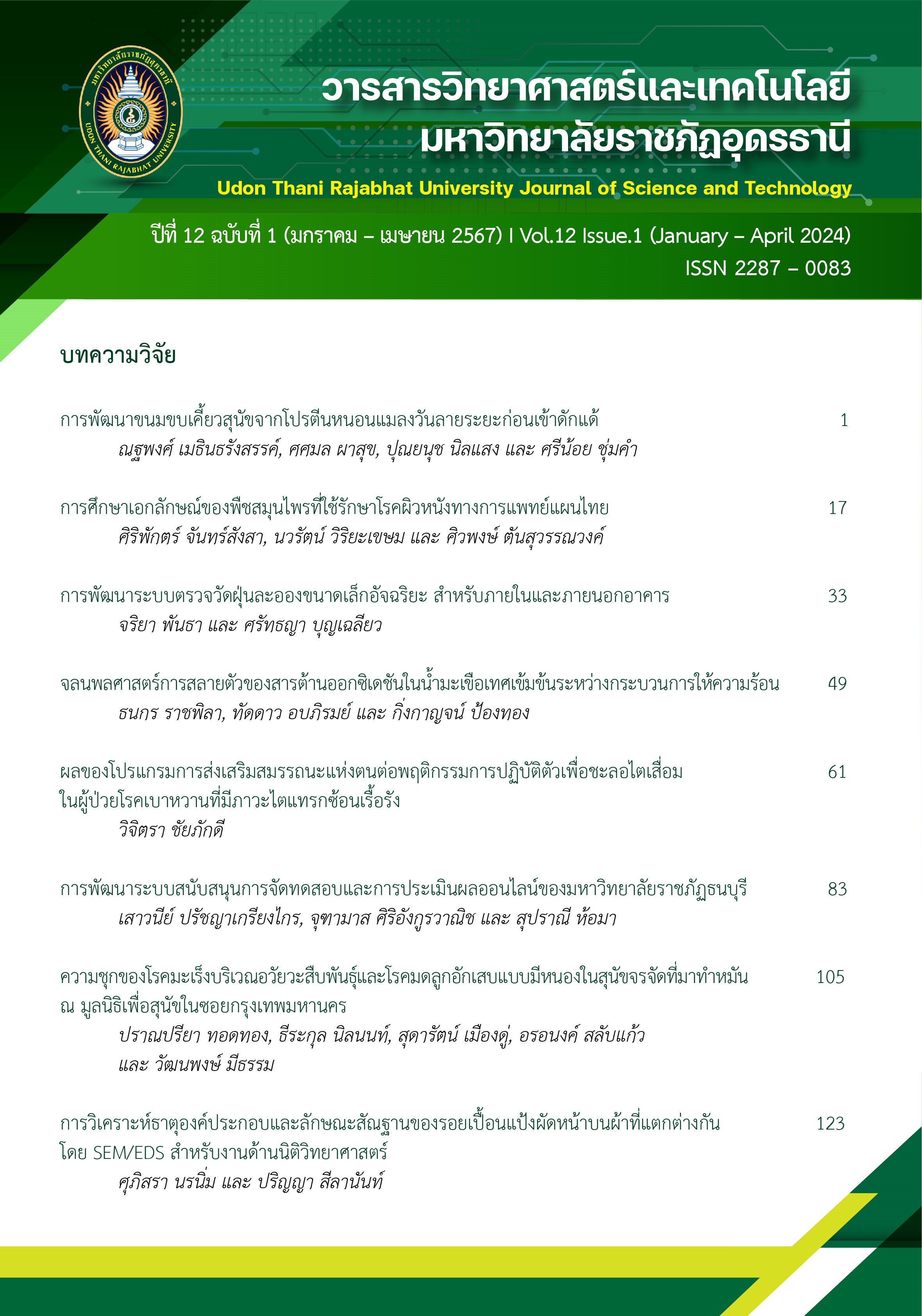ANALYSIS OF ELEMENT COMPOSITION AND MORPHOLOGICAL CHARACTERISTICS OF FACE POWDER STAIN ON DIFFERENT FABRICS USING SEM/EDS FOR FORENSIC APPLICATION
Main Article Content
Abstract
In forensic application, the objects that are exchanged in one area can be examined, compared, and linked to the incident, especially between the victim and the offender. Cosmetics are objects that can be exchanged between people. The objective of this research was to study cosmetic face powders that were simulated as stains on cotton and polyester fabric surfaces. Morphological characteristics and element compositions were analyzed by Scanning Electron Microscope combined with Energy Dispersive Spectroscopy (SEM/EDS). The results showed that the characteristics and composition of commercial face powders differed according to the type and ingredients of each product. All 3 samples of talc powder were with square shapes with various sizes of 38.6 ± 4.5 µm, 42.2 ± 3.5 µm, and 44.3 ± 8.9 µm. The silica type powder was in spherical shape of 8.2 ± 1.2 µm. The mica type powder was found to be square-shaped pieces with the size of 12.5 ± 1.1 µm containing spherical particles of 13.5 ± 2.2 µm in the powder. The element compositions of selected face powders were different. Talcum based powders contain the main elements of C, O, Mg, and Si while Zn was found in specific sample matched to the product report ingredients. The elements in Silica type powder were found with C, O, and Si. For Mica based powder, main element compositions were C, O, Si, and Mg whereas Al and K which are specifically from Mica minerals were observed. In summary, morphology, and composition of powder stains on fabric surfaces were consistent with each type of face powder. Hence, it can be used to perform comparison tests for types of face powder from the stain. This can be useful for the examination and as a database to support forensic application.
Article Details
References
ศิริณญา อยู่สุข. (2557). การวิเคราะห์แป้งผัดหน้าโดยเทคนิค Gas Chromatography (GC) และ X-Ray Diffraction (XRD) สำหรับประยุกต์ใช้ทางนิติวิทยาศาสตร์. รายงานการประขุมวิชาการและนำเสนอผลการวิจัยระดับชาติและนานาชาติ ครั้งที่ 5 กลุ่มระดับชาติด้านวิทยาศาสตร์ วันที่ 25-26 มีนาคม 2557, 5(1), 181-189. กรุงเทพฯ: มหาวิทยาลัยราชภัฏสวนสุนันทา.
Chophi, R., Sharma, S., Sharma, S., & Singh, R. (2019). Trends in the forensic analysis of cosmetic evidence. Forensic Chemistry, 14, 100165.
Ezegbogu, O. M., & Osadolor, B. H. (2019). Comparative Forensic Analysis of Lipsticks Using Thin Layer Chromatography and Gas Chromatography. International Scholarly and Scientific Research & Innovation, 13(5), 231-235.
Gardner, P., Bertino, F. M., & Hazelrigg, E. (2013). Analysis of lipsticks using Raman spectroscopy. Forensic Science International, 232(1), 67-72.
Gordon, A., & Coulson, S. (2004). The Evidential Value of Cosmetic Foundation Smears in Forensic Casework. Journal of Forensic Science, 49(6), 1244-1252.
Najjar, K., Blackledge, D. R., & Bridge, C. (2022). Leading Edge Techniques in Forensic Trace Evidence Analysis. New Jersey: John Wiley & Sons, Inc.
Nickell, J., & Fischer, J. F. (2014). Crime science: methods of forensic detection. University of Kentucky: University Press of Kentucky.
Richard, S. (2009). Forensic Science: From the Crime Scene to the Crime Lab. New Jersey: Pearson: Prentice Hall.
Steiling, W., Almeida, J. F., Assaf Vandecasteele, H., Gilpin, S., Kawamoto, T., O’Keeffe, L., Pappa, G., Rettinger, K., Rothe, H., & Bowden, M. A. (2018). Principles for the safety evaluation of cosmetic powders. Toxicology Letters, 297, 8-18.
Thongpagde, W., & Saksiri, N. (2022). Developing the Forensic Evidence and Problem in Murder Prosecution. Journal of Criminology and Forensic Science, 8(2), 186-203.


